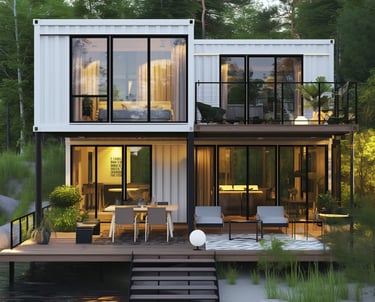10 Smart Ways to Save Money on Your Container Home in 2025


Building a container home or container house in USA can be an eco-friendly and cost-effective way to achieve homeownership. But even in 2025, prices can sneak up without careful planning. To help you build smart and stay on budget, here are 10 practical money-saving strategies, complete with educational insights and a focus on real-life savings. And, if you’re ready to streamline your project, check out these container home plans on Etsy—they’ve helped countless U.S. builders avoid costly delays and expensive reworks.
1. Choose the Right Container(s) and Buy Local
Why it matters: Shipping costs and transportation logistics often contribute significantly to the initial price.
Tip: Go for a used 40-foot high-cube container priced around $4,000–$6,000.
Strategy: Buy locally to cuts transport costs and reduce carbon emissions.
Extra savings: Inspect your container personally or hire a local inspector to avoid hidden rust or structural issues.
Average savings: $1,000–$2,000 in transport and inspection fees.
2. Use Ready-Made Container Home Plans
Why it matters: Custom architectural plans can cost $5,000–$12,000, not to mention permit delays.
Tip: Purchase permit-ready container home plans (usually $200–$800) tailored for U.S. codes.
Strategy: Modify plans slightly for site specifics—no need to reinvent the wheel.
Average savings: $4,000–$10,000 on design and permit costs plus a faster approval process.
3. Start With a Simple Foundation
Why it matters: Foundations can eat up 10–20% of your budget.
Tip: Choose a pier or gravel-pad foundation for $2,000–$5,000 if soil and slopes allow.
Strategy: Add crawlspace or slab later during phase 2 if needed.
Average savings: $5,000–$10,000 compared to full concrete slabs or basements.
4. Optimize Structural Modifications
Why it matters: Cutting, welding, and reinforcements can rack up big bills fast.
Tip: Stick to one or two containers, and limit large openings.
Strategy: Pre-plan window and door locations in your container home plans to avoid mid-build changes.
Average savings: $5,000–$10,000 by reducing unnecessary modifications.
5. Choose Cost-Effective Insulation
Why it matters: Proper insulation is vital for comfort and energy efficiency.
Tip: Use rigid foam insulation with interior framing for about $4,000–$8,000 for a mid-sized container.
Strategy: In hot or cold climates, only go spray foam ($6,000–$10,000) where it significantly reduces energy bills.
Average savings: $2,000–$4,000 with smart insulation matching climate needs.
6. Plan Utility Layouts Early
Why it matters: Electrical, plumbing, and HVAC are major line items. Sloppy planning = costly redesigns.
Tip: Pre-wire and plumb in the walls before finishing surfaces.
Strategy: Integrate mini-splits, water-saving fixtures, and LED lighting upfront for long-term savings.
Average savings: $3,000–$6,000 in avoided rework and utility bills.
7. Phase Your Interior Finishes
Why it matters: Finishes like cabinetry, flooring, and fixtures are flexible.
Tip: Use budget finishes (vinyl planks, basic cabinets) for phase one, and upgrade later as budget allows.
Strategy: Keep the essentials—kitchen, bath, HVAC—first; cosmetic upgrades come later.
Average savings: $5,000–$15,000 by spreading costs over time and avoiding high initial expenses.
8. DIY Where It Makes Sense
Why it matters: Labor is often 30–50% of total build costs.
Tip: DIY easy tasks—painting, tiling, trim work, landscaping.
Strategy: Always hire pros for structural work, permit inspections, electrical, plumbing, and HVAC to meet code and limit liability.
Average savings: $3,000–$8,000 in labor costs without compromising safety or structure.
9. Buy Smart Materials & Reuse Where You Can
Why it matters: Building materials can cost more than labor.
Tip: Use reclaimed wood for cabinets, shelving, or trim—check Habitat for Humanity ReStores and Craigslist.
Strategy: Buy appliances as scratch-and-dent models; keep insulation offcuts for future use.
Average savings: $2,000–$6,000 on building materials.
10. Use Green Incentives & Creative Financing
Why it matters: Incentives can offset many costs—and make your build more environmentally friendly.
Tip: Research Federal and state tax credits for energy-efficient appliances, solar, insulation, and water systems.
Strategy: Look into FHA PowerSaver, USDA loans, or VA financing if eligible. Use crowdfunding or phased equity investment for modular growth.
Average savings: 10–30% of your utility and build costs, depending on programs you qualify for.
Bonus Tip: Reuse Your Plans for Future Builds
Once you’ve used a set of container home plans successfully, save them. Next time you build—an ADU, guest cabin, or rental—they’re ready. You avoid design fees entirely, speeding permits and cutting prep costs by 90%.
Real-World Example: Mid-Sized Container House in Texas
A friend built a ~640 sq ft, two-container container house in Texas in 2025 by:
Buying two used 40-ft containers (3 hours from site)
Using economy foundation (gravel + piers)
Purchasing ready-made container home plans
DIYing paint, trim, and landscaping
Budget breakdown:
Containers & delivery: $12,000
Foundation + utility prep: $18,000
Structural修改 & insulation: $15,000
Electrical/plumbing/HVAC: $20,000
Basic finishes & DIY labor: $12,000
Permits & plans: $7,500
Total cost: $84,500 (~$132 per sq ft)—well under the common $150–$180 range.
They saved:
$5,000 on foundation choice
$8,000 using ready-made plans
$6,000 by DIYing finishes
$3,000 through local, reclaimed materials
Why This Matters for U.S. Builders
These money-saving steps help:
Lower upfront costs to under $100 per sq ft for efficient mid-sized builds.
Keep build time short—often within 6 months.
Combine eco-conscious design with financial prudence.
Smooth the build path with permit-ready, compliance-centered container home plans.
Ready to Build Smart?
If you’re gearing up for a container house in USA project, don’t overlook ready-made container home plans. They empower you to build confidently, save thousands, and streamline permits.
By combining thoughtful planning, smart material choices, strategic DIY, and financial savvy, you can build your container home in 2025 at a price that works—for both your pocket and your long-term goals. Let your next container home be cost-effective, sustainable, and uniquely yours.
